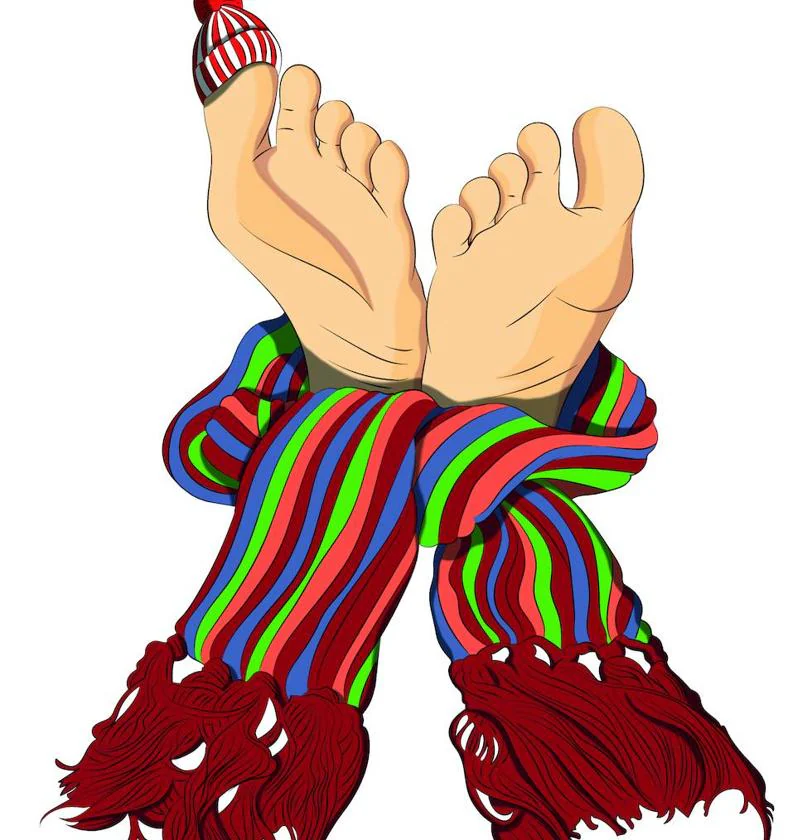Cold feet could be a sign of a health problem. Walk, take hot and cold showers, have massages and keep away from the radiator
If you constantly have cold feet it could be caused by an underlying health problem such as poor circulation, diabetes complications or Raynaud's
Marta Fernández Vallejo
Viernes, 14 de abril 2023, 11:12
It's quite common to have cold feet, especially in the winter when the temperatures drop. However, if it occurs constantly, at any time of year and is also accompanied by other physical symptoms, it could be a sign of a health problem.
These are some of the common conditions which could lie behind having cold feet, and many of them are related to bad circulation.
Circulation problems
"These are one of the most common causes," says Iban Cachorro, a specialist in Internal Medicine at the IMQ. Circulation problems make it difficult for the blood to reach the extremities and that creates the feeling of coldness.
One of these problems is peripheral arterial disease, which is characterised by a narrowing of the arteries outside the heart which then reduces blood flow to the extremities. The main risk factors for this condition are smoking, high blood pressure and high cholesterol and people are more likely to suffer from it as they get older.
Vasculitis
"This is an autoimmune illness - like lupus - which causes arterial inflammation," Dr Cachorro says. It reduces the peripheral blood flow and, therefore, can be the cause of cold hands and feet.
Arteriosclerosis
This condition, in which cholesterol can also play a part, also causes bad circulation and it affects blood flow to the extremities, creating the side effect of icy feet.
Complications in diabetes
When diabetes is not kept well-controlled, cardiovascular complications can occur or a diabetic peripheral neuropathy which damages the nerves and affects the circulation. It causes tingling, pins-and-needles, cold or numbness in the feet.
Raynaud's disease
This condition is characterised by an exaggerated reaction to changes in temperature and it is due to a vasospasm that impedes adequate blood flow to the extremities. "It takes the form of crises lasting 10 to 15 minutes or even hours, and it occurs in three phases. First the fingers turn white, as if they are bloodless. Then they go bluish or purplish when there is heat (this is cyanosis, because the blood is not moving) and, finally, red (repercussion, because the blood starts to flow again). It can be accompanied by pain, swelling and tingling in the fingers," according to the Spanish Rheumatology Foundation.
Sometimes other areas can be affected, such as the lips, nose and ears. "The factors that trigger it are changes in temperature (normally the cold), stressful or emotional situations," the Foundation says.
Advanced heart failure
"In this situation, the heart doesn't pump the blood properly," says Dr Cachorro, so it has difficulties in reaching the extremities and then the hands and feet get cold.
Smoking
Smoking is linked to the development of this condition. It causes inflammation in the blood vessels in the body, especially the arms and legs, creating the feeling of cold, and it can impede the flow of blood and result in clots forming.
Very severe anaemia
This is a condition which makes the body produce fewer red blood cells than normal, and those are responsible for transporting oxygen all round the body. The oxygen becomes concentrated on the vital organs and therefore does not reach the peripheral areas of the body so well.
Warning signs
When the feeling of cold is accompanied by other symptoms it can be a sign that we are suffering from a health problem.
The main warning signs are "pale feet, wounds or ulcers that don't heal, or areas where feeling has been lost," says Dr Cachorro. In fact, podologists often detect illnesses in their clients by the clues they find while treating their feet. "Toes that are white or unusually red, inflammation, wounds, areas with no hair, chilblains, they can all be a sign of bad circulation, complications of diabetes or heart problems, says María José Azcárate, a specialist in podology at the IMQ.
Having cold feet is an unpleasant feeling, but it is possible to alleviate it through different methods. "Walking is the best way, because it activates the circulation," says podologist María José Azcárate. Hot and cold showers are another 'trick' for warming up the feet. "You can start with either hot or cold water but you should always end with cold to contract the blood vessels. Otherwise they can collapse and that can cause tiny ruptures in them," she says. Foot massages are another effective option, because as the circulation is activated the body temperature rises. It is also possible to use special creams for blood circulation. One common mistake that people make, Azkarate says, is to put their feet on a heater, because "that strong contrast between cold and hot can also cause micro-ruptures of superficial vessels".
And eating spicy foods can also be helpful because they are beneficial for the blood circulation.



